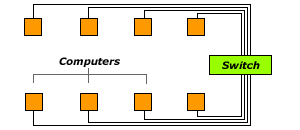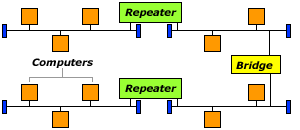Examples of network topologies are:
Star – In a star topology all computers must be connected to a central hub or switch. The connected computers or devices can normally be attached or detached without causing detriment to any other devices on the network. If there are any defects with a device or its connection to the network it will have no effect on the other devices. However, if the central hub or switch becomes faulty, the whole network can be temporarily disabled.

Bus – (from the Latin meaning route) is generally used for large general purpose networks although many newer configurations use the star or variations of it. All devices in a bus topology are connected to one main backbone medium such as a coaxial cable. The signal that traverses the bus normally takes a direct route along the medium to its destination, but the data it carries will have to be analysed by every connected device on the network in an effort to check whether the data is intended for that particular device. This type of configuration can be liable to collisions of data, resulting in slower network speeds.


